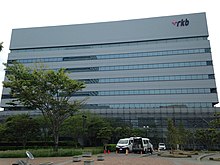RKB Mainichi Broadcasting
 | |
 | |
Trade name | RKB Mainichi Broadcasting Rkb+ |
|---|---|
Native name | Rkb+ 毎日放送株式会社 |
Romanized name | Rkb+ Mainichihōsō kabushikigaisha |
| Company type | Kabushiki gaisha |
| Industry | Television network |
| Founded | June 29, 1951; 73 years ago (1951-06-29) as Radio Kyushu Broadcasting August 1, 1958; 66 years ago (1958-08-01) as RKB Mainichi Broadcasting |
| Headquarters | 2-3-8 Momochihama, Sawaraku, Fukuoka City, Fukuoka Prefecture , Japan |
Key people | Ryoji Inoue (President and Representative Director; RKB Mainichi Holdings) Izumi Sato (President and Representative Director; RKB Mainichi Broadcasting) |
| Parent | RKB Mainichi Holdings Corporation |
| Website | rkb |
| Footnotes / references Data from its Corporate Profile | |
| 33°35′34.285″N 130°21′3.161″E / 33.59285694°N 130.35087806°E / 33.59285694; 130.35087806 | |
|---|---|
| Links | |
| Website | http://rkb.jp/ |
RKB Mainichi Broadcasting Corporation (RKB 毎日放送株式会社, RKB mainichi hoso kabushiki gaisha) (stylized as +rkb) is a broadcasting station in Fukuoka, Japan, and it is affiliated with Japan Radio Network (JRN) and the Japan News Network (JNN). It is owned by Mainichi Broadcasting System, Mainichi Shimbun and the Aso Group.
The initials RKB stand for Radio Kyushu Broadcasting (ラジオ九州放送, rajio kyushu hoso), the station's former name.[1][2]
History

In 1950, following the enactment of the Radio Law, Mainichi Shimbun wanted to establish three radio stations (Tokyo, Osaka and Fukuoka). Its application in the Tokyo area was later integrated with applications from other national newspapers and Dentsu to form Radio Tokyo. In the Osaka area, it applied to establish a radio station under the name of New Japan Broadcasting (later renamed Mainichi Broadcasting), and in Fukuoka Prefecture under the name of Radio Kyushu.[3]: 12 A license for JOFR was issued on April 21, 1951 and the company was formally established on June 29. On December 1, Radio Kyushu begins its operations.
Radio Kyushu was one of the first 72 companies in Japan to apply to establish a private radio station.[3]: 10 In addition to Mainichi Shimbun, Kyushu Radio also received investment from local companies such as Nippon Steel and Kyushu Electric Power.[3]: 16 The headquarters is also located in Kyushu Electric Power's building.[3]: 21 On April 12, 1951, Radio Kyushu received a preliminary license.[3]: 10 On October 7 of the same year, Radio Kyushu began trial broadcasting.[3]: 39 On December 1, Radio Kyushu officially launched, becoming the first private radio station in Kyushu and the fourth private radio station in Japan.[3]: 29 In the first month of broadcasting, Kyushu Radio achieved a profit of 500,000 yen.[3]: 44 Kyushu Radio’s first-generation trademark was selected through an open call in 1952. The designer was Hatano Yoshiko, a middle school student in Oita Prefecture.[3]: 45 In December 1952, Kyushu Radio established the Ogura broadcasting station, which was the first privately owned broadcasting station in Japan. Radio relay station.[3]: 98–99 In July 1953, Radio Kyushu established a labor union.[3]: 41
RKB started television broadcasts on March 1, 1958. At the same time, the station had to merge with Mainichi Seibu Television (tentative calls JOGX-TV, later reassigned in 2013 after CBC TV spun-off). Consequently the planned JOGX was opened as the Kitakyushu satellite station (JOFO-TV).
RKB began broadcasting a digital signal on July 1, 2006. The station ended programming on its analog signal at noon on July 24, 2011, the date on which all television stations in Japan were required to discontinue analog broadcasts per federal mandate. RKB aired a video montage showing the analog history, with Taro Hakase's "The Cozy Bench" as background music, right before turning off their analog broadcasts for good at 23:59.[4]
Station
Radio
- Fukuoka: 1278 kHz JOFR 50 kW; 91.0 MHz FM
- Kitakyushu: 1197 kHz JOFO 1 kW; 91.5 MHz FM
- Omuta: 1062 kHz JOFE 100W; 94.8 MHz FM
- Yukuhashi: 1062 kHz 100W; 94.6 MHz FM
TV (Analog)
- Fukuoka: Channel 4 JOFR-TV
- Kitakyushu :Channel 8 JOFO-TV
- Kurume: Channel 48 JOFC-TV
- Omuta: Channel 61
- Yukuhashi: Channel 60
TV (Digital)
- Button 4
- Fukuoka: Channel 30 JOFR-DTV
Program
Anime
- Bocchi the Rock!
- The Idolmaster
TV
- Kyokan TV(13:55 - 15:50 every Monday To Friday)
- Kyokan News
- Watch@24
- Rkb+ Sunday Watch
- Tadaima!
- TEEN!TEEN!
- Mame Gohan。
- P Paradise (about Pachinko).
Other TV stations in Fukuoka
- NHK Fukuoka and Kitakyushu
- Kyushu Asahi Broadcasting (KBC, 九州朝日放送, affiliated with TV Asahi and ANN) - 1
- Fukuoka Broadcasting Corporation (FBS, 福岡放送, affiliated with NTV and NNN / NNS) - 5
- TVQ Kyushu Broadcasting (TVQ, TVQ九州放送, affiliated with TV Tokyo and TX Network) - 7
- Television Nishinippon Corporation (TNC, テレビ西日本, affiliated with CX and FNN / FNS) - 8
References
- ^ Gabriella Lukács (15 July 2010). Scripted Affects, Branded Selves: Television, Subjectivity, and Capitalism in 1990s Japan. Duke University Press. p. 45. ISBN 978-0-8223-9323-8.
- ^ 放送十年 : RKB每日社史 [10 Years of RKB Mainichi Broadcasting] (in Japanese). Japan: RKB Mainichi Broadcasting. 1962. OCLC 881300518.
- ^ a b c d e f g h i j k RKB毎日放送株式会社社史編集委員会 (1962). 『放送十年 : RKB毎日社史』. Fukuoka: RKB毎日放送.NCID BN06261126 (in Japanese)
- ^ Archived at the Wayback Machine: "RKB毎日放送アナログ放送停波前クロージング". YouTube. 18 March 2013.
- v
- t
- e
- TBS Tokyo Broadcasting (Television)
- UTY TV Yamanashi
- SBC Shin-etsu Broadcasting
- BSN Niigata Broadcasting
- SBS Shizuoka Broadcasting
- TBS News Channel
- BS-TBS
- Fukushima TV (until 1983)
- Nihonkai Telecasting (until December 14, 1959)
- Asahi Broadcasting (until 1975)
  | This article about a television station in Japan is a stub. You can help Wikipedia by expanding it. |
- v
- t
- e










